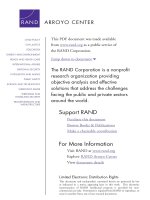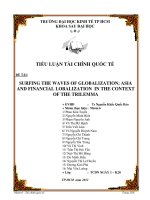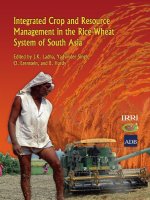PERIPATETIC PLANTS OF EASTERN ASIA
Bạn đang xem bản rút gọn của tài liệu. Xem và tải ngay bản đầy đủ của tài liệu tại đây (335.82 KB, 15 trang )
36
CHAPTER
4
PERIPATETIC PLANTS
OF EASTERN ASIA
We must also take into account the wheat pasta eaten in northern
China and Japan, countries usually thought of as consumers
of rice or pasta derived from rice.
Giovanni Rebora (1998)
TROPICAL TUCK OF SOUTHEAST ASIA
Asia, sprawling over the eastern portion of the Eurasian land mass as the
largest of the world’s continents was, not surprisingly, the site of many more
Neolithic upheavals than those that took place in the Fertile Crescent. Far to
its south and east – in East and Southeast Asia (Indochina) – parts of this vast
region can claim a close second in agricultural development.
1
Unfortunately,
monsoon Asia, with perhaps the best claim, lies in the tropical belt where
artifacts do not preserve well. Consequently there are considerable gaps in
the archeological record of foodstuffs and much remains speculative.
2
Banana and Plantain
It has been proposed that in the islands of Melanesia – especially Papua New
Guinea – around 9,000 years ago, or even earlier, bananas were cultivated by
Australoid peoples whose predecessors reached these Asian outposts by cross-
ing Indonesian land bridges that were later submerged. Geographically there
is no problem with this assertion. The wild ancestors of the domes ticated
Peripatetic Plants of Eastern Asia
37
banana, Musa acuminata and M. balbisiana,
(old usage designated the domesticated banana
M. sapientum – “fruit of the wise men” – and
the plantain M. paradisiaca – “heavenly fruit”)
were located in a region extending from New
Guinea to Thailand.
3
But there is a big question
about whether bananas were utilized as a food at
that point.
Banana domestication would have been a
lengthy process in which a small, seedy, ined-
ible fruit was transformed into a large, seed-
less, edible one (plantains are drier and less
sweet but bananas nonetheless). And it seems
likely that such a transformation transpired
because of another of those fortuitous accidents that so often greased the
domestication process.
Because wild bananas were inedible food, the plants must have initially
been cultivated to provide thatching to build shelters and fi bers to make
rope. Their leaves have myriad other uses including those of wrapping and
serving foods.
4
In addition, banana trees (actually giant herbs) are useful
for shading other crops. But out of banana-plant cultivation for these other
uses a sugar-, starch-, and nutrient-packed fruit would have sooner or later
emerged as an edible bonus. When this happened, we have no idea. A
Burmese legend explains that humans fi rst realized they could eat bananas
only after seeing birds eating them.
5
With this bonus the cultivation of banana plants – now capable of
feeding as well as housing people – spread to South Asia (where linguistic
evidence indicates that bananas have been utilized since circa 3000
BCE
)
and to East Asia, reaching south China toward the end of the fi rst millen-
nium
BCE
.
6
Between these dispersals another occurred as human pioneers
carried the fruits into Oceania by way of western to eastern Melanesia,
Polynesia, and Micronesia so that their cultivation was a familiar occu-
pation in many Pacifi c islands by 1000
AD
. When and how bananas
reached East Africa remains a matter of conjecture, with the best guess
being that they were carried across the Indian Ocean from Malaysia to
Madagascar around the end of the fi rst millennia
AD
. Following this, the
fruit moved westward across the continent to be named “banana” on the
Guinea Coast.
7
38
A Movable Feast
The question of whether bananas reached the New World before Colum-
bus has produced some lively controversy. In part the debate has centered
on the claim that banana remains were found in early Peruvian tombs and,
in part, on observations of early chroniclers, who assumed that banana trees
were native to the American tropics because they were so widespread.
Most authorities agree, however, that bananas only reached the Americas
from the Canary Islands in 1516 (where they had earlier been carried from
Africa by the Portuguese).
8
All of this, however, does introduce a persistent
and unresolved problem dealing with pre- Columbian America’s contact
with Oceania that we will encounter again with the sweet potato.
Ta r o
Taros are among the oldest of the world’s domesticated foods. There are
four kinds of root crops called “taro,” but only two of these – the “true taro”
(Colocasia esculenta) and the “false taro” ( Alocasia macrorrhiza) are widely
traveled.
9
The cradle of both may have been South Asia, although they
were under dry land cultivation in Southeast Asia 7,000 or more years ago,
and it is thought that the time and energy lavished on ancient terraces built
in Bali, Java, and the northern Philippines represents an investment in taro
propagation.
10
Wetland cultivation based on irrigation techniques whereby
taro was grown in prepared beds to control weeds was a later development
and dry land, or upland cultivation, has always been the most widespread
method of cultivating Colocasia taro.
Both taros began migrating with the Austronesians to reach the
Philippines around 8,000 years ago, and Melanesia about 4,000 years ago.
After this they sailed into the Pacifi c where they were carried by a hetero-
geneous people – a mixture of Austronesians and the earlier Australoids.
These were the greatest sailors of prehistory –
their voyages marked by the Lapita pottery
they left behind. Thanks to them taro became
a highly valued foodstuff, even in the remote
Hawaiian Islands where it is believed to have
always been the staple.
11
Colocasia taro also moved west to India, and
reached Egypt at the beginning of the Com-
mon Era. Shortly thereafter it was introduced
to Madagascar and spread throughout tropical
Peripatetic Plants of Eastern Asia
39
Africa. Around 714
AD
, taro was taken to Iberia by the Moors and 800
years later was carried to the Americas. Called “dasheen” or “eddoe” in
the Caribbean, it became an important food for African slaves.
12
Ya m
Several species of yams (genus Dioscorea) evolved separately in Asia,
Africa, and the Americas. Both the greater yam ( D. alata) and the lesser
yam ( D. esculenta) were domesticated in Southeast Asia perhaps 6,500 or
more years ago to join taro as a valuable root crop. From Southeast Asia
yams moved into Indonesia and reached Melanesia by 2000
BCE
, Microne-
sia a bit later, and eastern Polynesia by 1500
BCE
.
13
Yams were present in China by the third century
AD
and in India about
200 years later. They traversed the Indian Ocean to Madagascar a few
centuries after this (between the eleventh and the fi fteenth centuries) and,
by the end of the sixteenth century, D. alata had spanned the continent
to be cultivated in West Africa. From Africa it crossed the Atlantic to the
Americas in 1591 aboard a slave ship.
14
Africa also had native yams. Two of these D. cayenensis and D. rotun-
data, may have been domesticated in West Africa as many as 8,000 years
ago, suggesting an antiquity of agriculture south of the Sahara that some
scholars have diffi culty accepting. In part this is because African yam cul-
tivation only became widespread some 2,500 years ago with the advent of
iron working – a technology which provided the tools that made it possible
for people to expand deeper into forests where ecological circumstances
favored yams over grain crops.
15
In most of the New World tropics, sweet potatoes, white potatoes, and
manioc overshadowed the only native American yam ( D. trifi da ), which
was only a signifi cant food in the northern regions of South America and
in the Caribbean – areas where it is still widely cultivated today. Abroad
D. trifi da also found acceptance. It is cultivated on a limited basis in Sri
Lanka and Southeast Asia. On the Indian subcontinent it is called the
“India yam” and in Africa the “cush-cush” yam.
16
Rice
Sporadic arguments among scholars erupt from time to time over the issue
of whether root crop cultivation such as that of taro and yams preceded rice
40
A Movable Feast
in Southeast Asia. Pioneers from the region spread out into the Pacifi c
with taro and yams, but not rice, prompting the conclusion that Asian rice
(Oryza sativa) was not an important crop in Southeast Asia when they
departed. Confusion arises because their pioneering was done gradually
and in stages. It began about 8,000 years ago when Austronesian peoples
left Southeast Asia to fan out into the East Indies and the Philippine Islands,
but it was much later – thousands of years in fact – that they settled Mela-
nesia and then hived out into the Pacifi c. But – and this is the important
point – they did leave the mainland before rice became important there
around 5,500 years ago.
17
An explanation for this tardy appearance of rice in Southeast Asia holds
that it would have been diffi cult to cook it until pottery came into wide-
spread use, whereas taro and yams could have been easily baked in earthen
ovens or just tossed into the coals. A counterargument, of course, is that
western Asian hunter-gatherers collected wheat or barley for food long
before they had pottery. On the other hand they did not have such root
crop alternatives.
Wild self-propagating stands of rice would have
grown best in humid areas on poorly drained soils.
Cultivation began when grains were planted nearer
the home base, but much time probably elapsed
before wild rice – whose original home may have
been South Asia – became the domesticated
O. sativa that now is a staple for almost half of
the world’s population.
The slow march toward domestication prob-
ably began at about the same time in China and
India as it did in Southeast Asia – perhaps as
many as 10,000 years ago – but at that early date
rice was just one of many foods fi guring into
the diet. In Southeast Asia rice cultivation was
almost exclusively of the dry variety, probably
beginning in upland forest areas as well as small dooryard plots – primitive
forms of cultivation that still persist in remote areas. By contrast, wet rice
cultivation was not widely practiced in Southeast Asia until after the Suez
Canal was opened in 1869 – an event that greatly expanded trade to the
region at a time when European powers were looking for ways to feed grow-
ing colonial populations.
18
Peripatetic Plants of Eastern Asia
41
Other Fruits and Vegetables of Southeast Asia
The eggplant ( Solanum melongena) is an Old World relative of New World
tomatoes and potatoes. Also known as aubergines, eggplants were fi rst
domesticated in either Southeast Asia or India. They reached Spain with
the Muslims and from there moved north into Europe, south to Africa and
west to the Americas. Thomas Jefferson is said to have brought them to
North America.
19
Fruits such as the sweet pomelo (Citrus maxima) followed the same route
whereas lemons (Citrus limon) and limes ( Citrus aurantiifolia), although
natives of Southeast Asia, were apparently fi rst cultivated in India (where
Sanskrit names for both exist) and perhaps China as well. In fact lemons
seem to have been in China about 1900
BC
and reached Rome around the
beginning of the Common Era aboard Roman ships taking advantage of
the newly discovered route and techniques for sailing across the Indian
Ocean. Lemons are depicted in frescos and mosaics found at Pompeii. But
the Romans apparently regarded the lemon as an exotic fruit and there is
no written record of lemon cultivation in Europe until the Arabs in the
tenth century spread the fruit in the Mediterranean region.
Limes seem to have been domesticated in both India and China and
were later introduced to southern Europe – perhaps by the Crusaders as
well as the Arabs. Because limes were often viewed as green lemons, they
are more diffi cult to keep track of than lemons. The latter was growing in
the Azores in 1494 and both fruits began to fl ourish shortly after this in
the New World, where the small, tart lime has alternatively been called a
“Key” or “West Indian” or “Mexican” lime. (Persian limes are a recent cross
between the lime and the citron.)
CHINA’S CHIEF COMESTIBLES
Rice
Although wild rice may have originated in South Asia, it was fi rst cultivated in
China, probably in the Yangtze Basin – a river practically synonymous with rice
cultivation. Domesticated grains have been found there that are 7,000 years
old and rice was the principal food plant for many burgeoning Chinese settle-
ments. The cereal was originally cultivated on dry land, but with the advance of
the Neolithic, irrigation techniques were gradually applied to wetland cultiva-
tion, and ultimately rice seedlings were transplanted into wet fi elds.
20









